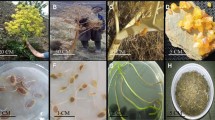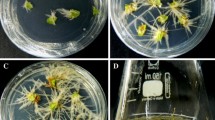Abstract
Tetrastigma hemsleyanum Diels & Gilg ex Diels (T. hemsleyanum) is an important medicinal plant in China. Its bulbous root is the most valuable part for medicine. There is an increasing demand for T. hemsleyanum in the medicinal market. However, the natural slow growth rate of T. hemsleyanum hardly meets the demand of the medicinal market. There is the need of alternative way for rapid and large-scale production of T. hemsleyanum. In this study, we investigated the induction of hairy roots by using Agrobacterium rhizogenes (A. rhizogenes) as an alternative method of increasing production of the secondary metabolites in hairy roots of T. hemsleyanum. Herein, we reported our successful induction of hairy roots of T. hemsleyanum by cucumopine type A. rhizogenes K599 and their rapid propagation. Firstly, we selected the optimal mediums for induction of hairy roots and for subculture of induced hairy roots. We found that when A. rhizogenes K599 carrying both an endogenous plasmid pRi2659 and an exogenous plasmid pRI101-AN-GFP was used to infect the leaves of T. hemsleyanum seedlings, the optimal medium for inducting hairy roots was the medium of MS + 0.4 mg/L 1-naphthaleneacetic acid. The optimal medium for subculture of hairy roots was the combination of MS + 1.0 mg/L indole-3-butyric acid + 0.5 or 1.0 mg/L kinetin. During suspension culture of hairy roots, the rapid growth phase occurred in the period of 15–28 days. Secondly, we employed polymerase chain reaction (PCR) assays to examine the integration of T-DNA of A. rhizogenes. The PCR results revealed the existence of a phenomenon of lacking of integration of one or more of 11 genes within T-DNA of plasmid pRi2659 into the genomic DNA of hairy roots. Thirdly, we conducted histocytological analysis to examine the structural features of the induced hairy roots and observed that xylem structures of the hairy roots were simplified as compared to those of the bulbous roots and ordinary fine roots of non-transgenic plant. Finally, we applied high performance liquid chromatography to analyze the medicinal components in several organs of the T. hemsleyanum plants. The results showed that the contents of kaempferol in all hairy root lines were significantly higher than those in bulbous roots, fine roots, stems and leaves. These results suggest that insertion and integration of T-DNA from A. rhizogenes can significantly increase the kaempferol content in hairy roots of T. hemsleyanum.







Similar content being viewed by others
Abbreviations
- 2, 4-D:
-
2, 4-Dichlorophenoxyacetic acid
- 6-BA:
-
6-Benzylaminopurine
- AS:
-
Acetosyringone
- Cef:
-
Cefotaxime sodium
- cus:
-
Cucumopine synthase
- FAA:
-
Formaldehyde-acetic acid-alcohol solution
- FITC:
-
Fluorescein isothiocyanate
- GFP:
-
Green fluorescent protein
- HPLC:
-
High performance liquid chromatography
- IBA:
-
3-Indolebutyric acid
- kD:
-
kiloDalton
- Km:
-
Kanamycin
- KT:
-
Kinetin
- MS:
-
Murashige and Skoog medium (1962)
- NAA:
-
α-Naphthaleneacetic acid
- OD:
-
Optical density
- ORF:
-
Open reading frame
- PCR:
-
Polymerase chain reaction
- rol:
-
Root loci
- Ri:
-
Root inducing plasmid
- Str:
-
Streptomycin
- T-DNA:
-
Transferred DNA
References
Bulgakov VP (2008) Functions of rol genes in plant secondary metabolism. Biotechnol Adv 26:318–324
Bulgakov VP, Shkryl YN, Veremeichik GN (2010) Engineering high yields of secondary metabolites in Rubia cell cultures through transformation with rol genes. Methods Mol Biol 643:229–242
Cao Q, Xiang T, Meng S, Wang S, Lu W (2012) Genetic stability analysis of exogenous gene in long-term cultured cucumber hairy roots. Acta Hort Sini 39:1589–1598 (in Chinese)
Chang CK, Chang KS, Lin YC, Liu SY, Chen CY (2005) Hairy root cultures of Gynostemma pentaphyllum (Thunb.) Makino: a promising approach for the production of gypenosides as an alternative of ginseng saponins. Biotechnol Lett 27:1165–1169
Feng Z, Hao W, Lin X, Fan D, Zhou J (2014) Antitumor activity of total flavonoids from Tetrastigma hemsleyanum Diels et Gilg is associated with the inhibition of regulatory T cells in mice. Onco Targets Ther 7:947–956
Fu CX, Xu YJ, Zhao DX, Ma FS (2006) A comparison between hairy root cultures and wild plants of Saussurea involucrata in phenylpropanoids production. Plant Cell Rep 24:750–754
Gandhi SG, Mahajan V, Bedi YS (2015) Changing trends in biotechnology of secondary metabolism in medicinal and aromatic plants. Planta 241:303–317
Guillon S, Tremouillaux-Guiller J, Pati PK, Rideau M, Gantet P (2006) Hairy root research: recent scenario and exciting prospects. Curr Opin Plant Bio 9:341–346
He F (2010) Research progress in anticancer effect of Tetrastigrna Hemsleyanum Diels et Gilg and its mechanism. J Oncol 16:75–77 (in Chinese)
Ji Q, Cheng W, Wu H, Zhu B, Hua J, Ji B (2014) Study on biological characteristics of Radix Tetrastigmue. Lishizhen Medi Materia Medica Res 25(1):219–221 (in Chinese)
Kochan E, Wasiela M, Sienkiewicz M (2013) The production of ginsenosides in hairy root cultures of American Ginseng, Panax quinquefolium L. and their antimicrobial activity. In Vitro Cell Dev Biol Plant 49:24–29
Liu D, Ju JH, Lin G, Xu XD, Yang JS, Tu GZ (2002) New C-glycosylflavones from Tetrastigma hemsleyanum (Vitaceae). Acta Bot Sini 44:227–229
Lu AF, Qi MJ, Li ZL, Lv HF (2010) Callus cultivation and determination of flavonoids from Tetrastigma hemsleyanum. Zhong Yao Cai 33:1042–1045 (in Chinese)
Mankin SL, Hill DS, Olhoft PM, Toren E, Wenck AR, Nea L, Xing L, Brown JA, Fu H, Ireland L, Jia H, Hillebrand H, Jones T, Song H-S, Ozias-Akins P (2007) Disarming and sequencing of Agrobacterium rhizogenes strain K599(NCPPB2659) plasmid pRi2659. In Vitro Cell Dev Biol Plant 43:521–535
Mathur A, Gangwar A, Mathur AK, Verma P, Uniyal GC, Lal RK (2010) Growth kinetics and ginsenosides production in transformed hairy roots of American ginseng—Panax quinquefolium L. Biotechnol Lett 32:457–461
Meng L, Ziv M, Lemaux PG (2006) Nature of stress and transgene locus influences transgene expression stability in barley. Plant Mol Biol 62:15–28
Murashige T, Skoog F (1962) A revised medium for rapid growth and bio assays with tobacco tissue culture. Physiol Plant 18:100–127
Pu J, Liang W, Zheng J, Hu T, Wei K (2011) Determination of content of quercetin and kaempferol in Tetrastigma Hemsleyanum by HPLC method. Chin J Trad Medi Sci Tech 18:134–135 (in Chinese)
Qian L (2008) In vitro Propagation of Tetrastigma hemsleyanum Diels et GIIg. Plant Physiol Commun 44:121–122 (in Chinese)
Qin B, Ma L, Wang Y, Chen M, Lan X, Wu N, Liao Z (2014) Effects of acetylsalicylic acid and UV-B on gene expression and tropane alkaloid biosynthesis in hairy root cultures of Anisodus luridus. Plant Cell Tissue Organ Cult 117:483–490
Sathiyamoorthy S, In JG, Gayathri S, Kim YJ, Yang DCh (2010) Gene ontology study of methyl jasmonate-treated and non-treated hairy roots of Panax ginseng to identify genes involved in secondary metabolic pathway. Genetika 46:932–939
Serino G, Clerot D, Brevet J, Costantino P, Cardarelli M (1994) rol genes of Agrobacterium rhizogenes cucumopine strain: sequence, effects and pattern of expression. Plant Mol Biol 26:415–422
Shao Q, Deng Y, Shen H, Fang H, Zhao X (2011) Optimization of polysaccharides extraction from Tetrastigma hemsleyanum Diels et Gilg using response surface methodology. Int J Biol Macromol 49:958–962
Shi M, Kwok KW, Wu JY (2007) Enhancement of tanshinone production in Salvia miltiorrhiza Bunge (red or Chinese sage) hairy-root culture by hyperosmotic stress and yeast elicitor. Biotechnol Appl Biochem 46:191–196
Shkryl YN, Veremeichik GN, Bulgakov VP, Tchernoded GK, Mischenko NP, Fedoreyev SA, Zhuravlev YN (2008) Individual and combined effects of the rolA, B, and C genes on anthraquinone production in Rubia cordifolia transformed calli. Biotechnol Bioeng 100:118–125
Sun Y, Li H, Hu J, Li J, Fan YW, Liu XR, Deng ZY (2013) Qualitative and quantitative analysis of phenolics in Tetrastigma hemsleyanum and their antioxidant and antiproliferative activities. J Agric Food Chem 61:10507–10515
Xiang TH, Wang LL, Pang JL, Chen M, Xu C (2005) Hairy root induced by wild-type Agrobacterium rhizogenes K599 in soybean, cucumber and garden balsam in vivo. Yi Chuan 27:783–786 (in Chinese)
Xiang T, Wang L, Jiang H, Tian J (2011) Hairy roots induced by Agrobacterium rhizogenes K599 in chrysanthemum in Vivo and plant regeneration from hairy roots. Acta Hort Sini 38:1365–1370 (in Chinese)
Xu JM, Xiang TH (2008) Construction of a novel vector harboring green fluorescence protein gene (gfp) and high expression of gfp in transformed roots of Petunia hybrida. Yi Chuan 30:1069–1074 (in Chinese)
Xu CJ, Ding GQ, Fu JY, Meng J, Zhang RH, Lou XM (2008) Immunoregulatory effects of ethyl-acetate fraction of extracts from Tetrastigmahemsleyanum Diels et. Gilg on immune functions of ICR mice. Biomed Environ Sci 21:325–331
Zhang HC, Liu JM, Lu HY, Gao SL (2009) Enhanced flavonoid production in hairy root cultures of Glycyrrhiza uralensis Fisch by combining the over-expression of chalcone isomerase gene with the elicitation treatment. Plant Cell Rep 28:1205–1213
Zhang DX, Xiang TH, Li PH, Bao LM (2011) Transgenic plants of Petunia hybrida harboring the CYP2E1 gene efficiently remove benzene and toluene pollutants and improve resistance to formaldehyde. Genet Mol Bio 34:634–639
Zhu MX, Yan LH (2014) Resource investigation on rare and endangered She medicine Tetrastigma hemsleyanum in Zhejiang Province. Zhong Yao Cai 37:766–770
Ziemienowicz A (2010) Plant transgenesis. Methods Mol Biol 631:253–268
Acknowledgments
The work was supported by the Project of Zhejiang Provincial Key Laboratory for Genetic Improvement and Quality Control of Medicinal Plants (Grant No. 201302); the Hangzhou Science and Technology Development Plan (Grant No. 20110232B10) and the New-shoot Talents Program of Zhejiang Province (Grant No. 2013R421008).
Author information
Authors and Affiliations
Corresponding author
Electronic supplementary material
Below is the link to the electronic supplementary material.
Rights and permissions
About this article
Cite this article
Du, S., Xiang, T., Song, Y. et al. Transgenic hairy roots of Tetrastigma hemsleyanum: induction, propagation, genetic characteristics and medicinal components. Plant Cell Tiss Organ Cult 122, 373–382 (2015). https://doi.org/10.1007/s11240-015-0775-6
Received:
Accepted:
Published:
Issue Date:
DOI: https://doi.org/10.1007/s11240-015-0775-6




